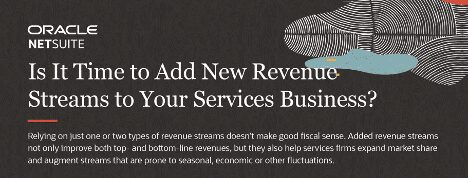Adding multiple revenue streams to a services business need not be complicated and expensive, but it does require a well thought out approach supported by a core technology system.
Few would argue the value of income diversification. Whether it’s a company, a career, or an investment portfolio, having multiple revenue streams is a smart approach. For a services business, diversifying can be as obvious as identifying gaps between what customers want or need and what you’re actually giving them. Or it can be as complex as figuring out what your clients should be doing—and what they’re actually doing on a day-to-day basis—and helping them achieve their higher goals.
Multiple revenue streams sound straightforward enough but not all companies are willing to put time, effort, and money into identifying them when business is booming, clients are plentiful and bottom lines are healthy. Instead, they opt to rely on a fixed income stream and let potential opportunities fall by the wayside, never to be explored.
Done properly, additional revenue streams can be a financially-beneficial way to not only boost a company’s revenue growth in a healthy economy but also help shield it from the negative impacts of an industry or economic downturn.
To complicate the issue, adding new services, finding new customers, hiring new employees, and scaling technological systems to accommodate the diversification can all place new pressures on already constrained resources. For example, the small to the midsized firm that’s historically focused on working with one or two customer groups—and providing them with a few defined services—may ignore the need for multiple revenue streams specifically for this reason.
Revenue can be uneven in the services business. The problem is that when business is brisk, there’s no time to get out and find new customers or revenue streams. When sales slow, everyone springs into “emergency mode” in an attempt to close revenue gaps, attract new customers, and increase sales.
These fluctuations make the continued scaling of existing business models (i.e., hiring, adopting new technology, signing on new customers, etc.) mandatory for services businesses. When the sales pipeline runs dry, for example, everyone scrambles to get as much as they can out of existing clients and customer verticals. This is a natural reaction to a slump in business but for best effect, at least some of that energy should go to branching out and diversifying into new revenue-generation strategies.
An IT VAR that’s historically focused on reselling computer hardware and software, for example, could transition over to a managed infrastructure service provider model. A VAR may purchase the hardware and software that its customers need, and then offer it on a subscription basis via the cloud or in the customer’s data center.
This is similar to Amazon Web Services or Google Cloud but on a much smaller scale and possibly hosted at the customer’s site. This model not only serves clients on a more holistic level but it also tends to attract more private equity and other types of investment funding.
HERE ARE SIX SIGNS THAT IT’S TIME TO ADD NEW REVENUE STREAMS TO YOUR SAAS OR PROFESSIONAL SERVICES BUSINESS
- You’ve been doing the same thing the same way for a really long time. Your current model may not sustain itself. Poll your customers and talk to your team to see what changes are in order.
- Your company is grappling with margin and revenue challenges. By providing a new crop of differentiated services, you can avoid this problem while also boosting profits.
- Your customer roster looks like it did 10 years ago. Could your firm be doing even more for both existing and prospective customers? Ask yourself this as you consider adding new services to your menu.
- Clients are asking for services that you can give them. The advertising firm focused on digital strategies that can add content production as an adjunct service, knowing that such services are in high demand right now.
- You’re over-leveraged in one business area or customer segment. Services businesses must have a range of offerings to keep their customer base engaged, being highly leveraged in one customer segment is just bad business. For example, if you are an implementation consultant that specializes in helping the sales team set up their CRM, adding offerings to help optimize or make tweaks to their environment would provide a powerful new revenue stream with wide application to your current customer basis.
- Those big-picture, strategic goals are getting put off. Solve this problem by keeping your firm’s values and mission at the forefront, even when putting out daily fires is taking up all of its energy and focus.





